Fibroids – Cynthia’s Case Study
VerifiedAdded on 2023/06/08
|11
|2494
|142
AI Summary
This article evaluates the case study of Cynthia who has undergone a surgery to remove fibroids. It includes the aetiology and pathophysiology of fibroids, Cynthia’s postoperative vital signs, an evaluation of the normal ranges of the vital signs and priorities of safe care as well as referrals.
Contribute Materials
Your contribution can guide someone’s learning journey. Share your
documents today.
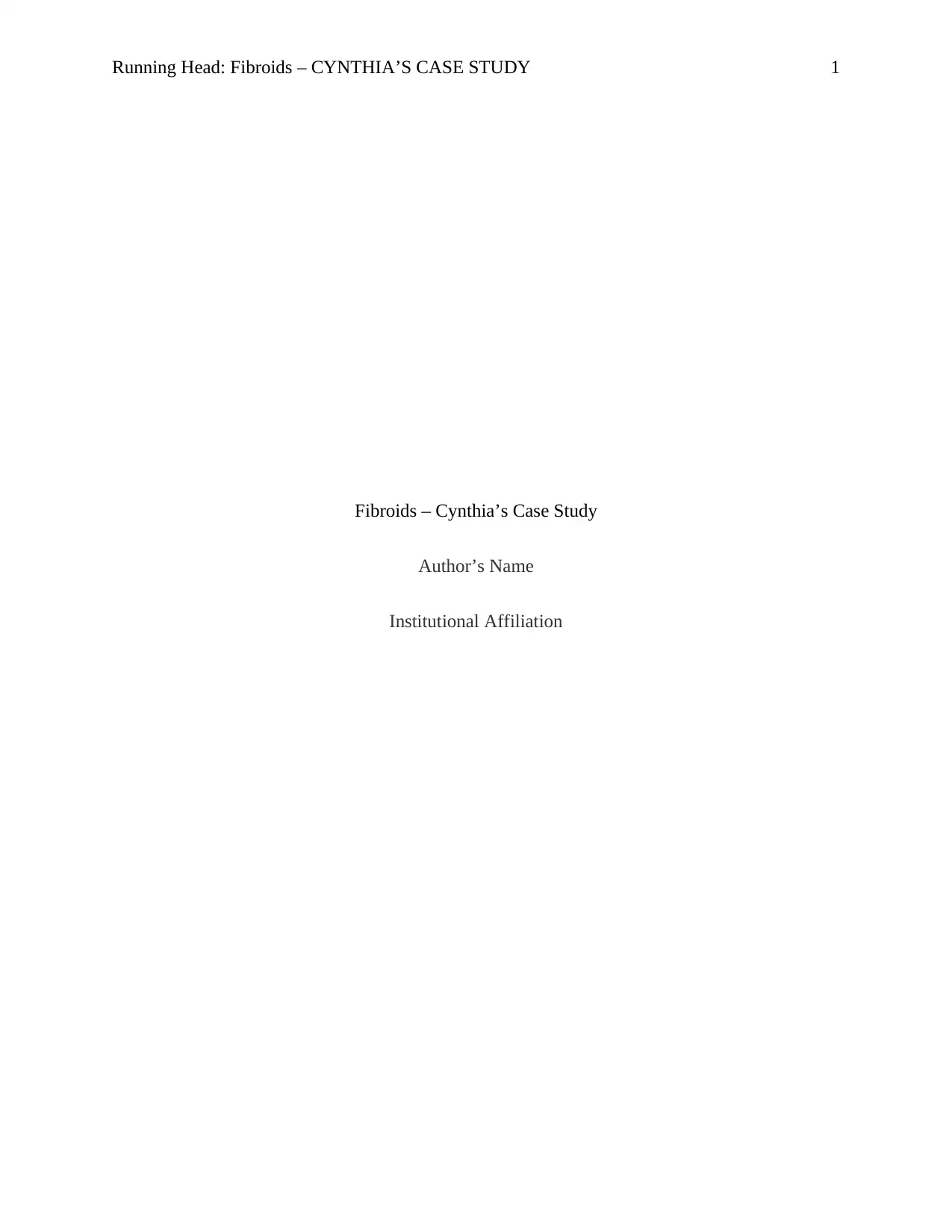
Running Head: Fibroids – CYNTHIA’S CASE STUDY 1
Fibroids – Cynthia’s Case Study
Author’s Name
Institutional Affiliation
Fibroids – Cynthia’s Case Study
Author’s Name
Institutional Affiliation
Secure Best Marks with AI Grader
Need help grading? Try our AI Grader for instant feedback on your assignments.
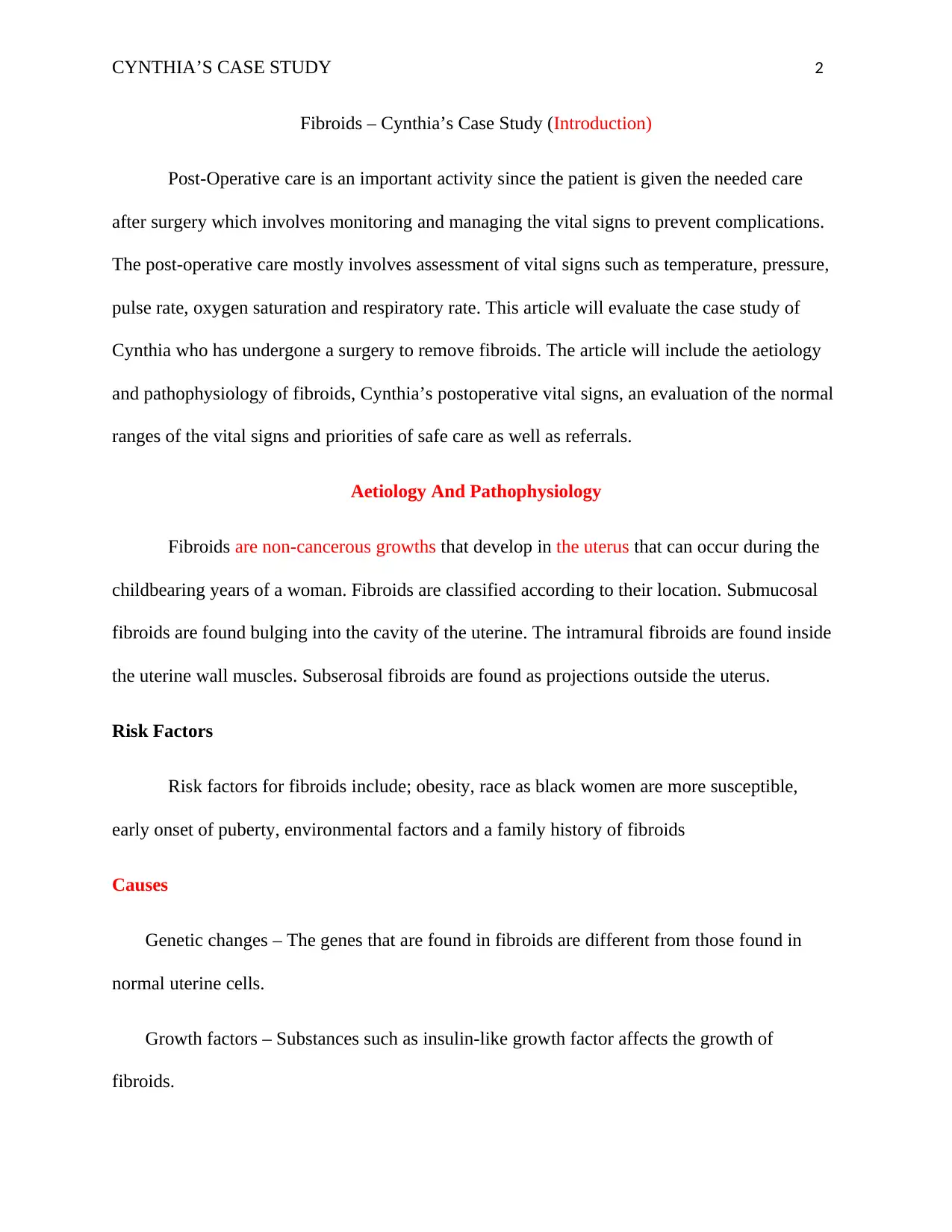
CYNTHIA’S CASE STUDY 2
Fibroids – Cynthia’s Case Study (Introduction)
Post-Operative care is an important activity since the patient is given the needed care
after surgery which involves monitoring and managing the vital signs to prevent complications.
The post-operative care mostly involves assessment of vital signs such as temperature, pressure,
pulse rate, oxygen saturation and respiratory rate. This article will evaluate the case study of
Cynthia who has undergone a surgery to remove fibroids. The article will include the aetiology
and pathophysiology of fibroids, Cynthia’s postoperative vital signs, an evaluation of the normal
ranges of the vital signs and priorities of safe care as well as referrals.
Aetiology And Pathophysiology
Fibroids are non-cancerous growths that develop in the uterus that can occur during the
childbearing years of a woman. Fibroids are classified according to their location. Submucosal
fibroids are found bulging into the cavity of the uterine. The intramural fibroids are found inside
the uterine wall muscles. Subserosal fibroids are found as projections outside the uterus.
Risk Factors
Risk factors for fibroids include; obesity, race as black women are more susceptible,
early onset of puberty, environmental factors and a family history of fibroids
Causes
Genetic changes – The genes that are found in fibroids are different from those found in
normal uterine cells.
Growth factors – Substances such as insulin-like growth factor affects the growth of
fibroids.
Fibroids – Cynthia’s Case Study (Introduction)
Post-Operative care is an important activity since the patient is given the needed care
after surgery which involves monitoring and managing the vital signs to prevent complications.
The post-operative care mostly involves assessment of vital signs such as temperature, pressure,
pulse rate, oxygen saturation and respiratory rate. This article will evaluate the case study of
Cynthia who has undergone a surgery to remove fibroids. The article will include the aetiology
and pathophysiology of fibroids, Cynthia’s postoperative vital signs, an evaluation of the normal
ranges of the vital signs and priorities of safe care as well as referrals.
Aetiology And Pathophysiology
Fibroids are non-cancerous growths that develop in the uterus that can occur during the
childbearing years of a woman. Fibroids are classified according to their location. Submucosal
fibroids are found bulging into the cavity of the uterine. The intramural fibroids are found inside
the uterine wall muscles. Subserosal fibroids are found as projections outside the uterus.
Risk Factors
Risk factors for fibroids include; obesity, race as black women are more susceptible,
early onset of puberty, environmental factors and a family history of fibroids
Causes
Genetic changes – The genes that are found in fibroids are different from those found in
normal uterine cells.
Growth factors – Substances such as insulin-like growth factor affects the growth of
fibroids.
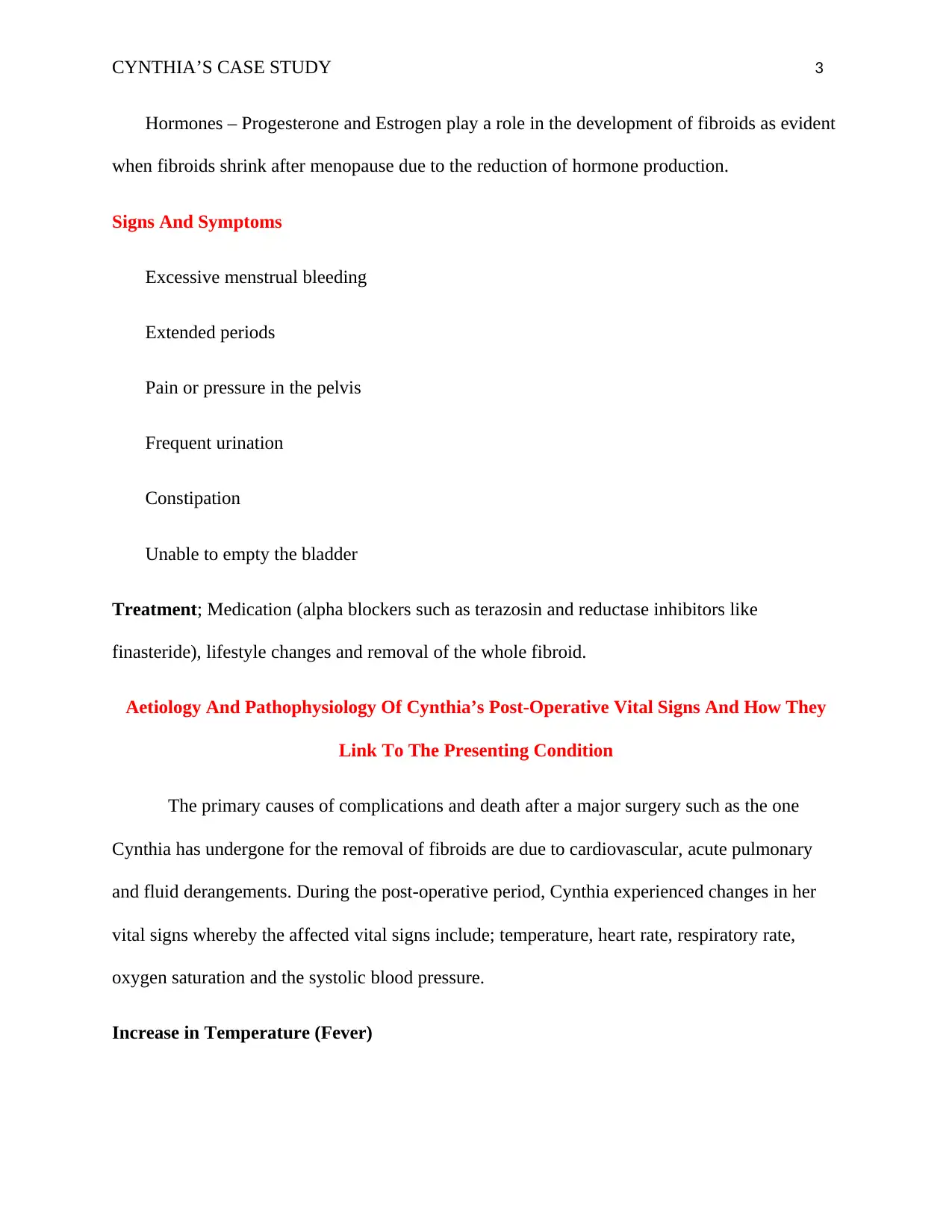
CYNTHIA’S CASE STUDY 3
Hormones – Progesterone and Estrogen play a role in the development of fibroids as evident
when fibroids shrink after menopause due to the reduction of hormone production.
Signs And Symptoms
Excessive menstrual bleeding
Extended periods
Pain or pressure in the pelvis
Frequent urination
Constipation
Unable to empty the bladder
Treatment; Medication (alpha blockers such as terazosin and reductase inhibitors like
finasteride), lifestyle changes and removal of the whole fibroid.
Aetiology And Pathophysiology Of Cynthia’s Post-Operative Vital Signs And How They
Link To The Presenting Condition
The primary causes of complications and death after a major surgery such as the one
Cynthia has undergone for the removal of fibroids are due to cardiovascular, acute pulmonary
and fluid derangements. During the post-operative period, Cynthia experienced changes in her
vital signs whereby the affected vital signs include; temperature, heart rate, respiratory rate,
oxygen saturation and the systolic blood pressure.
Increase in Temperature (Fever)
Hormones – Progesterone and Estrogen play a role in the development of fibroids as evident
when fibroids shrink after menopause due to the reduction of hormone production.
Signs And Symptoms
Excessive menstrual bleeding
Extended periods
Pain or pressure in the pelvis
Frequent urination
Constipation
Unable to empty the bladder
Treatment; Medication (alpha blockers such as terazosin and reductase inhibitors like
finasteride), lifestyle changes and removal of the whole fibroid.
Aetiology And Pathophysiology Of Cynthia’s Post-Operative Vital Signs And How They
Link To The Presenting Condition
The primary causes of complications and death after a major surgery such as the one
Cynthia has undergone for the removal of fibroids are due to cardiovascular, acute pulmonary
and fluid derangements. During the post-operative period, Cynthia experienced changes in her
vital signs whereby the affected vital signs include; temperature, heart rate, respiratory rate,
oxygen saturation and the systolic blood pressure.
Increase in Temperature (Fever)
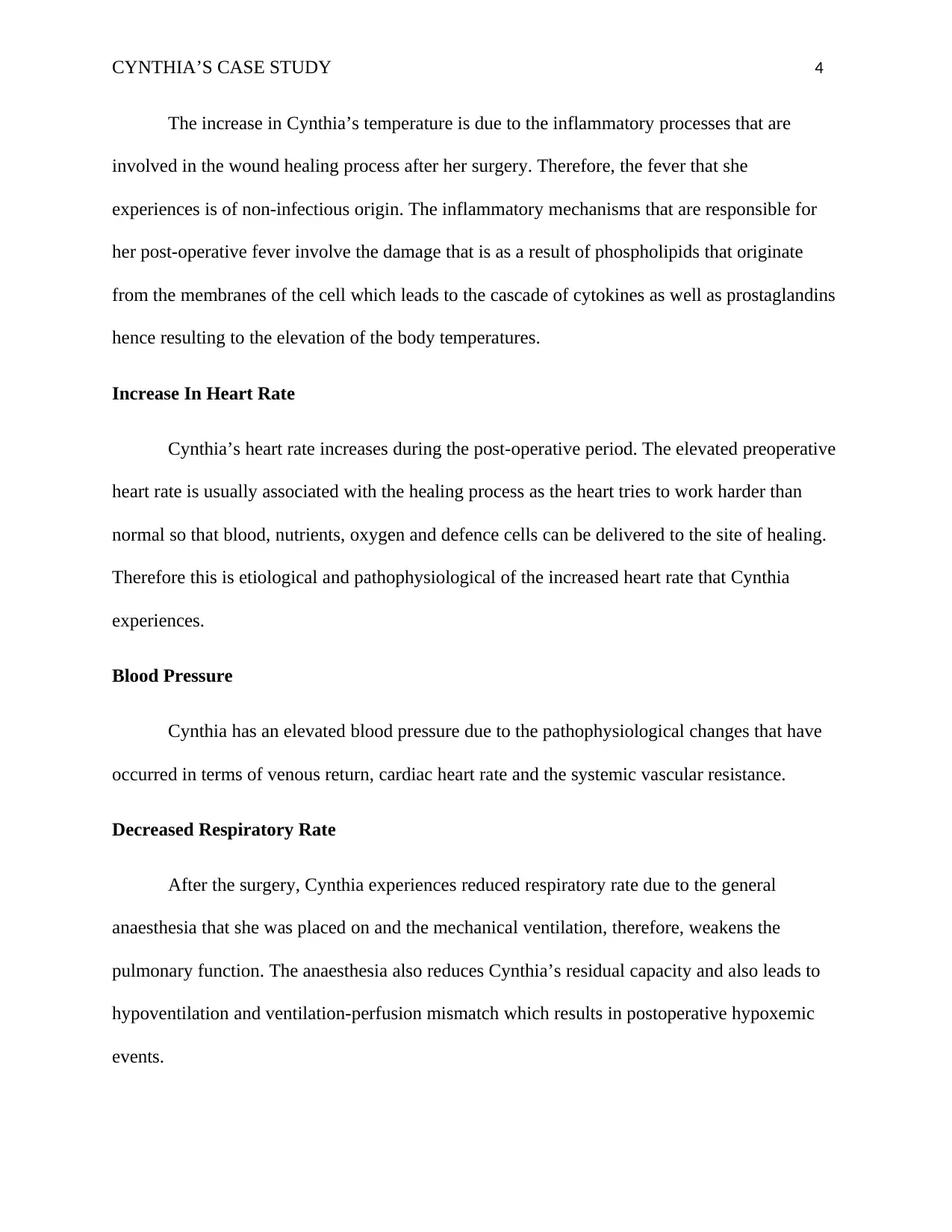
CYNTHIA’S CASE STUDY 4
The increase in Cynthia’s temperature is due to the inflammatory processes that are
involved in the wound healing process after her surgery. Therefore, the fever that she
experiences is of non-infectious origin. The inflammatory mechanisms that are responsible for
her post-operative fever involve the damage that is as a result of phospholipids that originate
from the membranes of the cell which leads to the cascade of cytokines as well as prostaglandins
hence resulting to the elevation of the body temperatures.
Increase In Heart Rate
Cynthia’s heart rate increases during the post-operative period. The elevated preoperative
heart rate is usually associated with the healing process as the heart tries to work harder than
normal so that blood, nutrients, oxygen and defence cells can be delivered to the site of healing.
Therefore this is etiological and pathophysiological of the increased heart rate that Cynthia
experiences.
Blood Pressure
Cynthia has an elevated blood pressure due to the pathophysiological changes that have
occurred in terms of venous return, cardiac heart rate and the systemic vascular resistance.
Decreased Respiratory Rate
After the surgery, Cynthia experiences reduced respiratory rate due to the general
anaesthesia that she was placed on and the mechanical ventilation, therefore, weakens the
pulmonary function. The anaesthesia also reduces Cynthia’s residual capacity and also leads to
hypoventilation and ventilation-perfusion mismatch which results in postoperative hypoxemic
events.
The increase in Cynthia’s temperature is due to the inflammatory processes that are
involved in the wound healing process after her surgery. Therefore, the fever that she
experiences is of non-infectious origin. The inflammatory mechanisms that are responsible for
her post-operative fever involve the damage that is as a result of phospholipids that originate
from the membranes of the cell which leads to the cascade of cytokines as well as prostaglandins
hence resulting to the elevation of the body temperatures.
Increase In Heart Rate
Cynthia’s heart rate increases during the post-operative period. The elevated preoperative
heart rate is usually associated with the healing process as the heart tries to work harder than
normal so that blood, nutrients, oxygen and defence cells can be delivered to the site of healing.
Therefore this is etiological and pathophysiological of the increased heart rate that Cynthia
experiences.
Blood Pressure
Cynthia has an elevated blood pressure due to the pathophysiological changes that have
occurred in terms of venous return, cardiac heart rate and the systemic vascular resistance.
Decreased Respiratory Rate
After the surgery, Cynthia experiences reduced respiratory rate due to the general
anaesthesia that she was placed on and the mechanical ventilation, therefore, weakens the
pulmonary function. The anaesthesia also reduces Cynthia’s residual capacity and also leads to
hypoventilation and ventilation-perfusion mismatch which results in postoperative hypoxemic
events.
Secure Best Marks with AI Grader
Need help grading? Try our AI Grader for instant feedback on your assignments.
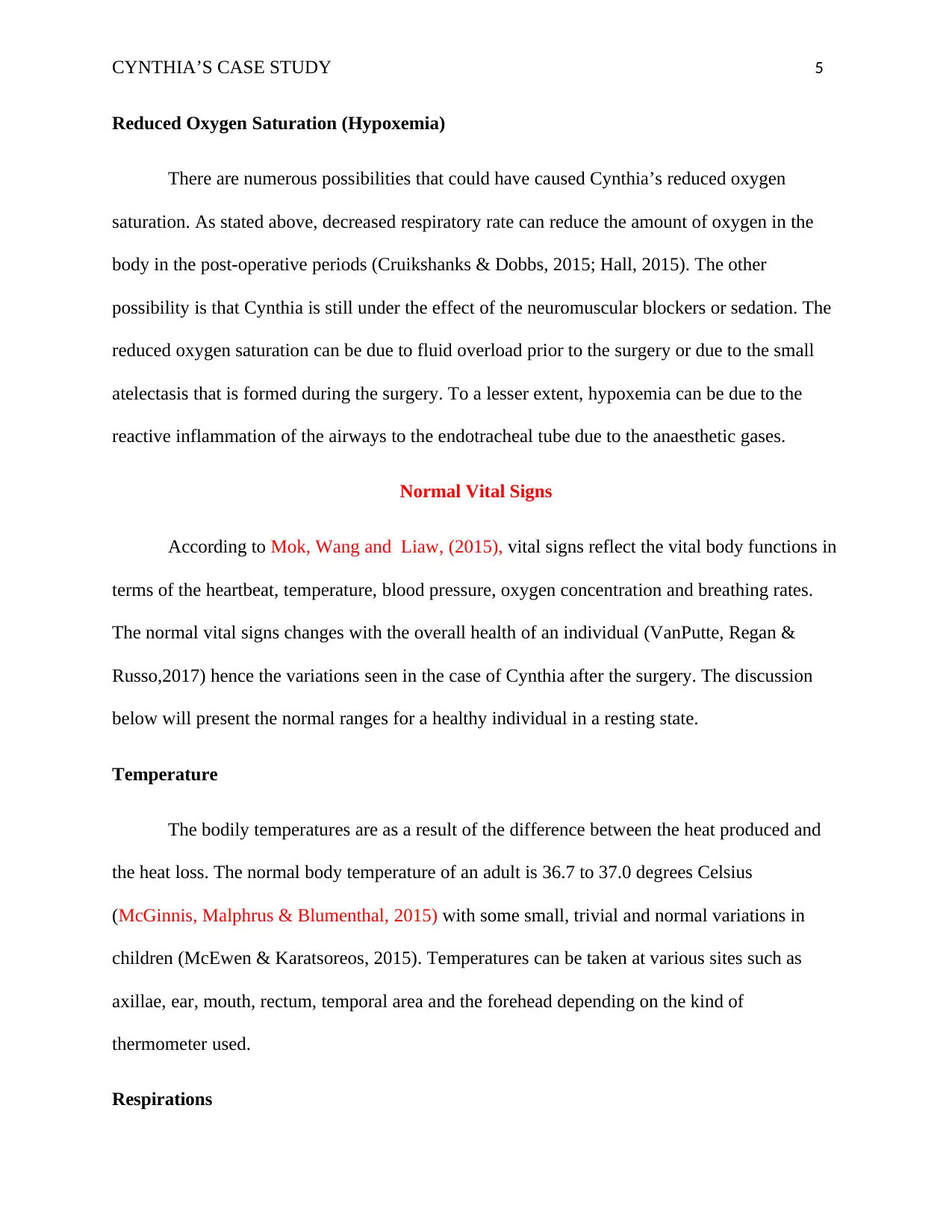
CYNTHIA’S CASE STUDY 5
Reduced Oxygen Saturation (Hypoxemia)
There are numerous possibilities that could have caused Cynthia’s reduced oxygen
saturation. As stated above, decreased respiratory rate can reduce the amount of oxygen in the
body in the post-operative periods (Cruikshanks & Dobbs, 2015; Hall, 2015). The other
possibility is that Cynthia is still under the effect of the neuromuscular blockers or sedation. The
reduced oxygen saturation can be due to fluid overload prior to the surgery or due to the small
atelectasis that is formed during the surgery. To a lesser extent, hypoxemia can be due to the
reactive inflammation of the airways to the endotracheal tube due to the anaesthetic gases.
Normal Vital Signs
According to Mok, Wang and Liaw, (2015), vital signs reflect the vital body functions in
terms of the heartbeat, temperature, blood pressure, oxygen concentration and breathing rates.
The normal vital signs changes with the overall health of an individual (VanPutte, Regan &
Russo,2017) hence the variations seen in the case of Cynthia after the surgery. The discussion
below will present the normal ranges for a healthy individual in a resting state.
Temperature
The bodily temperatures are as a result of the difference between the heat produced and
the heat loss. The normal body temperature of an adult is 36.7 to 37.0 degrees Celsius
(McGinnis, Malphrus & Blumenthal, 2015) with some small, trivial and normal variations in
children (McEwen & Karatsoreos, 2015). Temperatures can be taken at various sites such as
axillae, ear, mouth, rectum, temporal area and the forehead depending on the kind of
thermometer used.
Respirations
Reduced Oxygen Saturation (Hypoxemia)
There are numerous possibilities that could have caused Cynthia’s reduced oxygen
saturation. As stated above, decreased respiratory rate can reduce the amount of oxygen in the
body in the post-operative periods (Cruikshanks & Dobbs, 2015; Hall, 2015). The other
possibility is that Cynthia is still under the effect of the neuromuscular blockers or sedation. The
reduced oxygen saturation can be due to fluid overload prior to the surgery or due to the small
atelectasis that is formed during the surgery. To a lesser extent, hypoxemia can be due to the
reactive inflammation of the airways to the endotracheal tube due to the anaesthetic gases.
Normal Vital Signs
According to Mok, Wang and Liaw, (2015), vital signs reflect the vital body functions in
terms of the heartbeat, temperature, blood pressure, oxygen concentration and breathing rates.
The normal vital signs changes with the overall health of an individual (VanPutte, Regan &
Russo,2017) hence the variations seen in the case of Cynthia after the surgery. The discussion
below will present the normal ranges for a healthy individual in a resting state.
Temperature
The bodily temperatures are as a result of the difference between the heat produced and
the heat loss. The normal body temperature of an adult is 36.7 to 37.0 degrees Celsius
(McGinnis, Malphrus & Blumenthal, 2015) with some small, trivial and normal variations in
children (McEwen & Karatsoreos, 2015). Temperatures can be taken at various sites such as
axillae, ear, mouth, rectum, temporal area and the forehead depending on the kind of
thermometer used.
Respirations
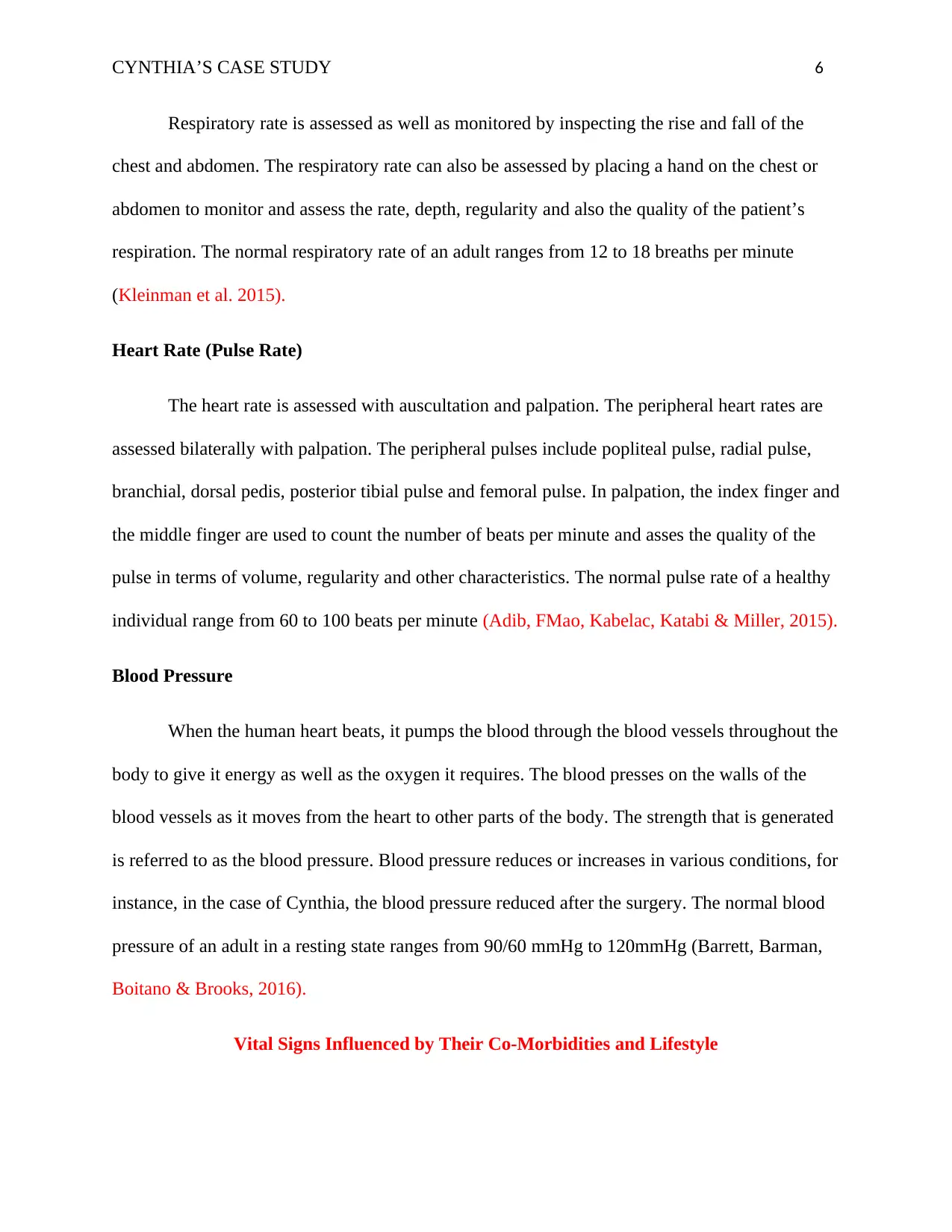
CYNTHIA’S CASE STUDY 6
Respiratory rate is assessed as well as monitored by inspecting the rise and fall of the
chest and abdomen. The respiratory rate can also be assessed by placing a hand on the chest or
abdomen to monitor and assess the rate, depth, regularity and also the quality of the patient’s
respiration. The normal respiratory rate of an adult ranges from 12 to 18 breaths per minute
(Kleinman et al. 2015).
Heart Rate (Pulse Rate)
The heart rate is assessed with auscultation and palpation. The peripheral heart rates are
assessed bilaterally with palpation. The peripheral pulses include popliteal pulse, radial pulse,
branchial, dorsal pedis, posterior tibial pulse and femoral pulse. In palpation, the index finger and
the middle finger are used to count the number of beats per minute and asses the quality of the
pulse in terms of volume, regularity and other characteristics. The normal pulse rate of a healthy
individual range from 60 to 100 beats per minute (Adib, FMao, Kabelac, Katabi & Miller, 2015).
Blood Pressure
When the human heart beats, it pumps the blood through the blood vessels throughout the
body to give it energy as well as the oxygen it requires. The blood presses on the walls of the
blood vessels as it moves from the heart to other parts of the body. The strength that is generated
is referred to as the blood pressure. Blood pressure reduces or increases in various conditions, for
instance, in the case of Cynthia, the blood pressure reduced after the surgery. The normal blood
pressure of an adult in a resting state ranges from 90/60 mmHg to 120mmHg (Barrett, Barman,
Boitano & Brooks, 2016).
Vital Signs Influenced by Their Co-Morbidities and Lifestyle
Respiratory rate is assessed as well as monitored by inspecting the rise and fall of the
chest and abdomen. The respiratory rate can also be assessed by placing a hand on the chest or
abdomen to monitor and assess the rate, depth, regularity and also the quality of the patient’s
respiration. The normal respiratory rate of an adult ranges from 12 to 18 breaths per minute
(Kleinman et al. 2015).
Heart Rate (Pulse Rate)
The heart rate is assessed with auscultation and palpation. The peripheral heart rates are
assessed bilaterally with palpation. The peripheral pulses include popliteal pulse, radial pulse,
branchial, dorsal pedis, posterior tibial pulse and femoral pulse. In palpation, the index finger and
the middle finger are used to count the number of beats per minute and asses the quality of the
pulse in terms of volume, regularity and other characteristics. The normal pulse rate of a healthy
individual range from 60 to 100 beats per minute (Adib, FMao, Kabelac, Katabi & Miller, 2015).
Blood Pressure
When the human heart beats, it pumps the blood through the blood vessels throughout the
body to give it energy as well as the oxygen it requires. The blood presses on the walls of the
blood vessels as it moves from the heart to other parts of the body. The strength that is generated
is referred to as the blood pressure. Blood pressure reduces or increases in various conditions, for
instance, in the case of Cynthia, the blood pressure reduced after the surgery. The normal blood
pressure of an adult in a resting state ranges from 90/60 mmHg to 120mmHg (Barrett, Barman,
Boitano & Brooks, 2016).
Vital Signs Influenced by Their Co-Morbidities and Lifestyle
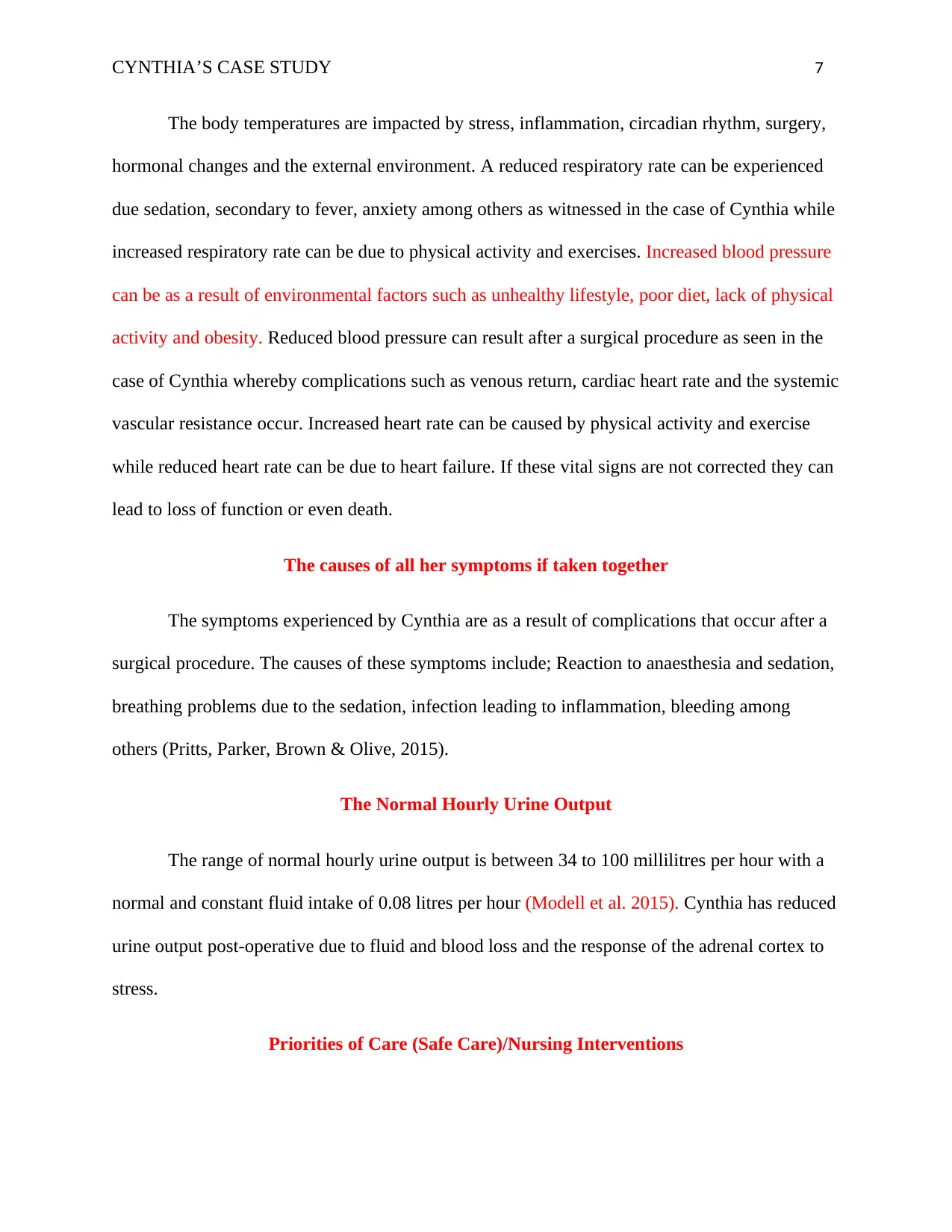
CYNTHIA’S CASE STUDY 7
The body temperatures are impacted by stress, inflammation, circadian rhythm, surgery,
hormonal changes and the external environment. A reduced respiratory rate can be experienced
due sedation, secondary to fever, anxiety among others as witnessed in the case of Cynthia while
increased respiratory rate can be due to physical activity and exercises. Increased blood pressure
can be as a result of environmental factors such as unhealthy lifestyle, poor diet, lack of physical
activity and obesity. Reduced blood pressure can result after a surgical procedure as seen in the
case of Cynthia whereby complications such as venous return, cardiac heart rate and the systemic
vascular resistance occur. Increased heart rate can be caused by physical activity and exercise
while reduced heart rate can be due to heart failure. If these vital signs are not corrected they can
lead to loss of function or even death.
The causes of all her symptoms if taken together
The symptoms experienced by Cynthia are as a result of complications that occur after a
surgical procedure. The causes of these symptoms include; Reaction to anaesthesia and sedation,
breathing problems due to the sedation, infection leading to inflammation, bleeding among
others (Pritts, Parker, Brown & Olive, 2015).
The Normal Hourly Urine Output
The range of normal hourly urine output is between 34 to 100 millilitres per hour with a
normal and constant fluid intake of 0.08 litres per hour (Modell et al. 2015). Cynthia has reduced
urine output post-operative due to fluid and blood loss and the response of the adrenal cortex to
stress.
Priorities of Care (Safe Care)/Nursing Interventions
The body temperatures are impacted by stress, inflammation, circadian rhythm, surgery,
hormonal changes and the external environment. A reduced respiratory rate can be experienced
due sedation, secondary to fever, anxiety among others as witnessed in the case of Cynthia while
increased respiratory rate can be due to physical activity and exercises. Increased blood pressure
can be as a result of environmental factors such as unhealthy lifestyle, poor diet, lack of physical
activity and obesity. Reduced blood pressure can result after a surgical procedure as seen in the
case of Cynthia whereby complications such as venous return, cardiac heart rate and the systemic
vascular resistance occur. Increased heart rate can be caused by physical activity and exercise
while reduced heart rate can be due to heart failure. If these vital signs are not corrected they can
lead to loss of function or even death.
The causes of all her symptoms if taken together
The symptoms experienced by Cynthia are as a result of complications that occur after a
surgical procedure. The causes of these symptoms include; Reaction to anaesthesia and sedation,
breathing problems due to the sedation, infection leading to inflammation, bleeding among
others (Pritts, Parker, Brown & Olive, 2015).
The Normal Hourly Urine Output
The range of normal hourly urine output is between 34 to 100 millilitres per hour with a
normal and constant fluid intake of 0.08 litres per hour (Modell et al. 2015). Cynthia has reduced
urine output post-operative due to fluid and blood loss and the response of the adrenal cortex to
stress.
Priorities of Care (Safe Care)/Nursing Interventions
Paraphrase This Document
Need a fresh take? Get an instant paraphrase of this document with our AI Paraphraser
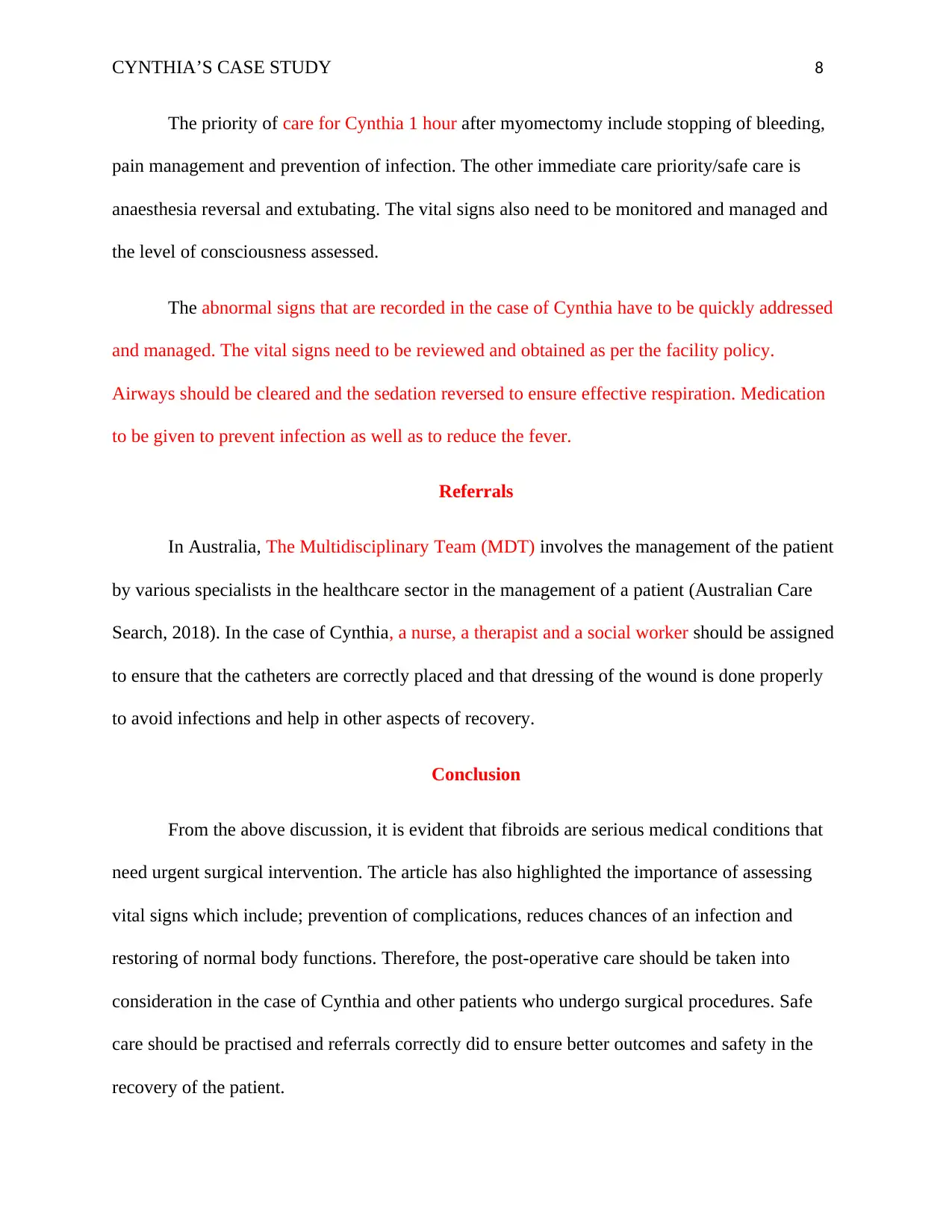
CYNTHIA’S CASE STUDY 8
The priority of care for Cynthia 1 hour after myomectomy include stopping of bleeding,
pain management and prevention of infection. The other immediate care priority/safe care is
anaesthesia reversal and extubating. The vital signs also need to be monitored and managed and
the level of consciousness assessed.
The abnormal signs that are recorded in the case of Cynthia have to be quickly addressed
and managed. The vital signs need to be reviewed and obtained as per the facility policy.
Airways should be cleared and the sedation reversed to ensure effective respiration. Medication
to be given to prevent infection as well as to reduce the fever.
Referrals
In Australia, The Multidisciplinary Team (MDT) involves the management of the patient
by various specialists in the healthcare sector in the management of a patient (Australian Care
Search, 2018). In the case of Cynthia, a nurse, a therapist and a social worker should be assigned
to ensure that the catheters are correctly placed and that dressing of the wound is done properly
to avoid infections and help in other aspects of recovery.
Conclusion
From the above discussion, it is evident that fibroids are serious medical conditions that
need urgent surgical intervention. The article has also highlighted the importance of assessing
vital signs which include; prevention of complications, reduces chances of an infection and
restoring of normal body functions. Therefore, the post-operative care should be taken into
consideration in the case of Cynthia and other patients who undergo surgical procedures. Safe
care should be practised and referrals correctly did to ensure better outcomes and safety in the
recovery of the patient.
The priority of care for Cynthia 1 hour after myomectomy include stopping of bleeding,
pain management and prevention of infection. The other immediate care priority/safe care is
anaesthesia reversal and extubating. The vital signs also need to be monitored and managed and
the level of consciousness assessed.
The abnormal signs that are recorded in the case of Cynthia have to be quickly addressed
and managed. The vital signs need to be reviewed and obtained as per the facility policy.
Airways should be cleared and the sedation reversed to ensure effective respiration. Medication
to be given to prevent infection as well as to reduce the fever.
Referrals
In Australia, The Multidisciplinary Team (MDT) involves the management of the patient
by various specialists in the healthcare sector in the management of a patient (Australian Care
Search, 2018). In the case of Cynthia, a nurse, a therapist and a social worker should be assigned
to ensure that the catheters are correctly placed and that dressing of the wound is done properly
to avoid infections and help in other aspects of recovery.
Conclusion
From the above discussion, it is evident that fibroids are serious medical conditions that
need urgent surgical intervention. The article has also highlighted the importance of assessing
vital signs which include; prevention of complications, reduces chances of an infection and
restoring of normal body functions. Therefore, the post-operative care should be taken into
consideration in the case of Cynthia and other patients who undergo surgical procedures. Safe
care should be practised and referrals correctly did to ensure better outcomes and safety in the
recovery of the patient.
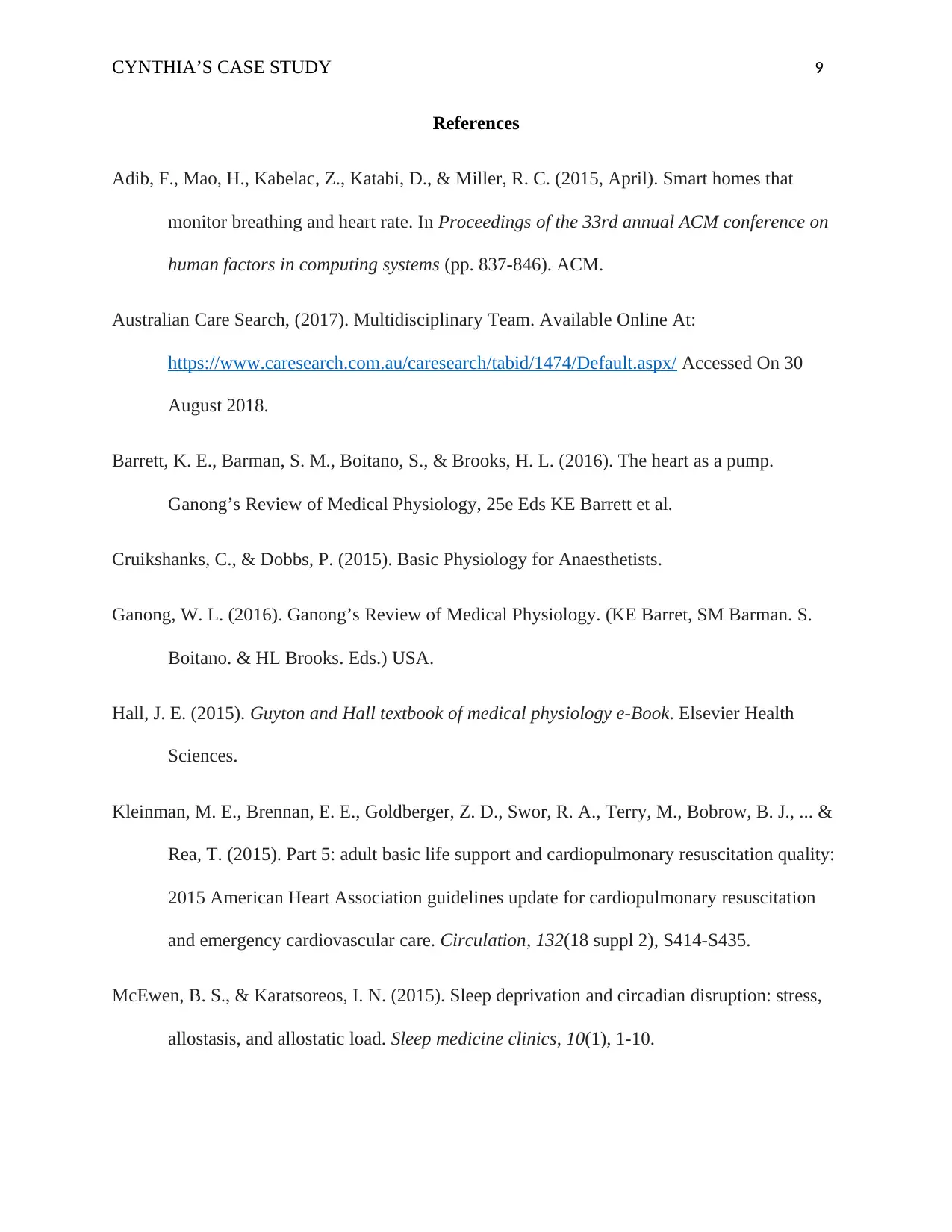
CYNTHIA’S CASE STUDY 9
References
Adib, F., Mao, H., Kabelac, Z., Katabi, D., & Miller, R. C. (2015, April). Smart homes that
monitor breathing and heart rate. In Proceedings of the 33rd annual ACM conference on
human factors in computing systems (pp. 837-846). ACM.
Australian Care Search, (2017). Multidisciplinary Team. Available Online At:
https://www.caresearch.com.au/caresearch/tabid/1474/Default.aspx/ Accessed On 30
August 2018.
Barrett, K. E., Barman, S. M., Boitano, S., & Brooks, H. L. (2016). The heart as a pump.
Ganong’s Review of Medical Physiology, 25e Eds KE Barrett et al.
Cruikshanks, C., & Dobbs, P. (2015). Basic Physiology for Anaesthetists.
Ganong, W. L. (2016). Ganong’s Review of Medical Physiology. (KE Barret, SM Barman. S.
Boitano. & HL Brooks. Eds.) USA.
Hall, J. E. (2015). Guyton and Hall textbook of medical physiology e-Book. Elsevier Health
Sciences.
Kleinman, M. E., Brennan, E. E., Goldberger, Z. D., Swor, R. A., Terry, M., Bobrow, B. J., ... &
Rea, T. (2015). Part 5: adult basic life support and cardiopulmonary resuscitation quality:
2015 American Heart Association guidelines update for cardiopulmonary resuscitation
and emergency cardiovascular care. Circulation, 132(18 suppl 2), S414-S435.
McEwen, B. S., & Karatsoreos, I. N. (2015). Sleep deprivation and circadian disruption: stress,
allostasis, and allostatic load. Sleep medicine clinics, 10(1), 1-10.
References
Adib, F., Mao, H., Kabelac, Z., Katabi, D., & Miller, R. C. (2015, April). Smart homes that
monitor breathing and heart rate. In Proceedings of the 33rd annual ACM conference on
human factors in computing systems (pp. 837-846). ACM.
Australian Care Search, (2017). Multidisciplinary Team. Available Online At:
https://www.caresearch.com.au/caresearch/tabid/1474/Default.aspx/ Accessed On 30
August 2018.
Barrett, K. E., Barman, S. M., Boitano, S., & Brooks, H. L. (2016). The heart as a pump.
Ganong’s Review of Medical Physiology, 25e Eds KE Barrett et al.
Cruikshanks, C., & Dobbs, P. (2015). Basic Physiology for Anaesthetists.
Ganong, W. L. (2016). Ganong’s Review of Medical Physiology. (KE Barret, SM Barman. S.
Boitano. & HL Brooks. Eds.) USA.
Hall, J. E. (2015). Guyton and Hall textbook of medical physiology e-Book. Elsevier Health
Sciences.
Kleinman, M. E., Brennan, E. E., Goldberger, Z. D., Swor, R. A., Terry, M., Bobrow, B. J., ... &
Rea, T. (2015). Part 5: adult basic life support and cardiopulmonary resuscitation quality:
2015 American Heart Association guidelines update for cardiopulmonary resuscitation
and emergency cardiovascular care. Circulation, 132(18 suppl 2), S414-S435.
McEwen, B. S., & Karatsoreos, I. N. (2015). Sleep deprivation and circadian disruption: stress,
allostasis, and allostatic load. Sleep medicine clinics, 10(1), 1-10.
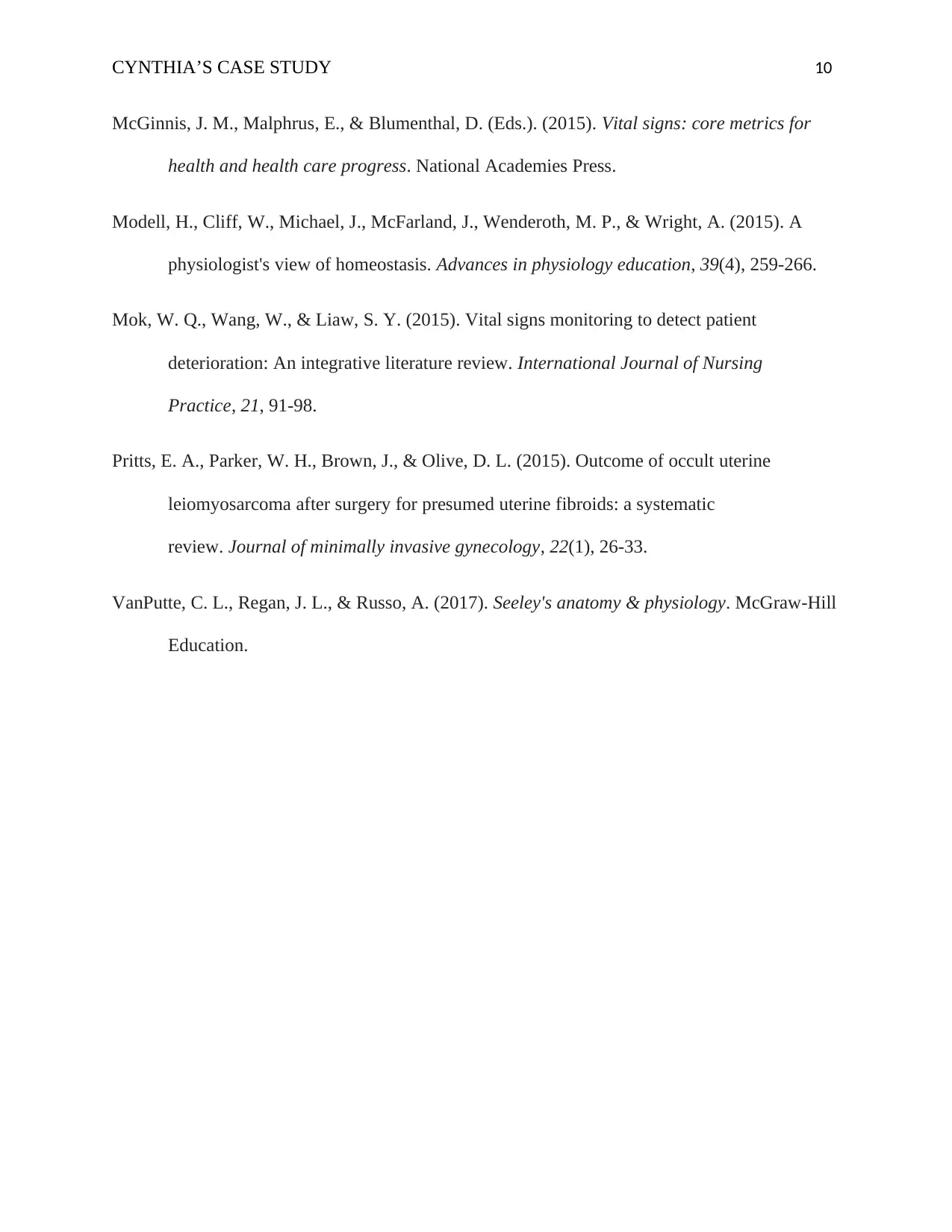
CYNTHIA’S CASE STUDY 10
McGinnis, J. M., Malphrus, E., & Blumenthal, D. (Eds.). (2015). Vital signs: core metrics for
health and health care progress. National Academies Press.
Modell, H., Cliff, W., Michael, J., McFarland, J., Wenderoth, M. P., & Wright, A. (2015). A
physiologist's view of homeostasis. Advances in physiology education, 39(4), 259-266.
Mok, W. Q., Wang, W., & Liaw, S. Y. (2015). Vital signs monitoring to detect patient
deterioration: An integrative literature review. International Journal of Nursing
Practice, 21, 91-98.
Pritts, E. A., Parker, W. H., Brown, J., & Olive, D. L. (2015). Outcome of occult uterine
leiomyosarcoma after surgery for presumed uterine fibroids: a systematic
review. Journal of minimally invasive gynecology, 22(1), 26-33.
VanPutte, C. L., Regan, J. L., & Russo, A. (2017). Seeley's anatomy & physiology. McGraw-Hill
Education.
McGinnis, J. M., Malphrus, E., & Blumenthal, D. (Eds.). (2015). Vital signs: core metrics for
health and health care progress. National Academies Press.
Modell, H., Cliff, W., Michael, J., McFarland, J., Wenderoth, M. P., & Wright, A. (2015). A
physiologist's view of homeostasis. Advances in physiology education, 39(4), 259-266.
Mok, W. Q., Wang, W., & Liaw, S. Y. (2015). Vital signs monitoring to detect patient
deterioration: An integrative literature review. International Journal of Nursing
Practice, 21, 91-98.
Pritts, E. A., Parker, W. H., Brown, J., & Olive, D. L. (2015). Outcome of occult uterine
leiomyosarcoma after surgery for presumed uterine fibroids: a systematic
review. Journal of minimally invasive gynecology, 22(1), 26-33.
VanPutte, C. L., Regan, J. L., & Russo, A. (2017). Seeley's anatomy & physiology. McGraw-Hill
Education.
Secure Best Marks with AI Grader
Need help grading? Try our AI Grader for instant feedback on your assignments.

CYNTHIA’S CASE STUDY 11
1 out of 11
Related Documents
Your All-in-One AI-Powered Toolkit for Academic Success.
+13062052269
info@desklib.com
Available 24*7 on WhatsApp / Email
![[object Object]](/_next/static/media/star-bottom.7253800d.svg)
Unlock your academic potential
© 2024 | Zucol Services PVT LTD | All rights reserved.




